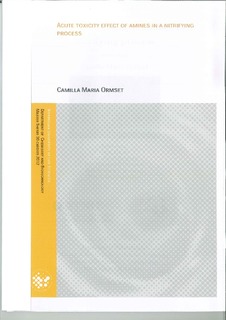| dc.description.abstract | The longest continuous record of atmospheric CO2 is found at the Mauna Loa observatory in Hawaii. Looking at the overall scenario the measurements show a steady increase in mean atmospheric CO2 concentration from about 315 parts per million (ppm) in 1958 to 393,65 ppm in February 2012.The good news is that it is possible to reduce global emissions by as much as 85 percent by 2050; one of the measures to achieve this is the use of CO2 capture and storage (CCS).
The principle of CCS is to capture the CO2 from arising point sources and transport and store it safely in an underground geological formation. One of three main technologies of CCS is post-combustion capture, where the most commonly used method is absorption based on chemical solvents, such as amines and carbonates.
For post-combustion capture aqueous amines are the most common solvents and a solvent with 30 % of monoethanolamine (MEA) is the industry standard. Other commonly used amines are 2-amino-2-methyl-1-propanol (AMP, sterically hindered primary amine), methyldiethanolamine (MDEA, tertiary amine), diethanolamine (DEA, secondary amine) and cyclic piperazine.
To enable better solvent management and ultimately ensure that post-combustion capture of CO2 power stations has a net positive human and environmental benefit it is important and necessary to prioritize waste monitoring and management, including liquid and solid waste, at the pilot scale.
The main purpose of this work was to investigate the feasibility of applying biological Nitrogen removal to remove the ammonia from the process water from a CO2 capture plant based on amine absorption, were the main concern is the possible toxicity of the high amine content in the process water to the nitrifying bacteria culture.
In this work pilot studies were run in separate bench scale reactors both for nitrification and denitrification, exposing the nitrifying culture for MEA, AMP, DEA, MDEA and piperazine. By Hach-Lange assays and Fluorescamine assay the nitrification and denitrification process could be followed and the degradation of primary amines could be monitored.
The work was based on previous studies done by Colaço, Skjæran and Hauser (Colaço, 2009, Skjæran, 2010, Hauser, 2011) to try to reproduce the results gained from the acute toxicity of the amines MEA, AMP, DEA, MDEA and piperazine on a nitrifying biofilm previously exposed, versus a freshly developed nitrifying biofilm not previously exposed.
Experimental results indicated that the activity of the nitrifying culture stabilized around day 43 after the inoculation. The gained COD per Kaldnes K1 carrier in the nitrification culture could not be tracked because of interference on the Hach-Lange assay LCK 114 COD.
Comparing the acute toxicity of MEA unloaded with the acute toxicity of the MEA loaded (with 5 % CO2 in air) the affect on the nitrifying culture was relative similar, except for when comparing the percentage recovery, which showed that the MEA unloaded recovers faster than the MEA loaded. The Fluorescamine assay gave a good correlation between the measured and the theoretical MEA concentration, indicating that there was no degradation of MEA during the time period of the acute toxicity test.
Overall, the EC50 values for the ammonia oxidizing rate (AOR) were less than the EC50 values for the nitrite oxidizing rate (NOR) (except for MDEA, which had a higher EC50 value for the AOR), indicating that the AOR was more sensitive to lower concentrations during the acute toxicity than the NOR. The activity of the nitrifying process varied during the toxicity tests, but it did not stop. The tolerance in amine concentration represented by the EC50 values for the AOR in ascending order: MEA unloaded (58 mM) < AMP (82 mM) < DEA (138 mM) < piperazine (190 mM) < MDEA (314 mM). The tolerance in amine concentration represented by the EC50 values for the NOR in ascending order: MDEA (104 mM) < MEA unloaded (168 mM).
The EC50 values can be used as an indication on how much the reclaimer waste has to be diluted when using biological degradation of the effluent from amine based CCS. | no_NO |
